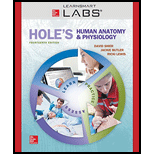
To determine:
The way in which joints are classified.
Introduction:
Joints are the structures in the body that help in the movement of the bones. They help humans in locomotion. There are various types of joints on the basis of their structure and functions. They can also be classified on the basis of the type of tissue that binds the bones at the joints.
Explanation of Solution
The ways in which joints are classified are the structural basis and the functional basis. They are elaborated as follows.
On the basis of structure, joints can be fibrous joints, cartilaginous joints, and the structural joints. Fibrous joints are the joints that are formed of collagen fibers. They are again subdivided into three sub-types which are syndesmosis, sutures, and gomphosis.
Cartilaginous joints are those joints that are formed of cartilage. They are of two types:synchondrosis and symphysis.
Synovial joints are those joints that allow the free movement of the constituting bones. They are more complex than the other two structural joints. They are made up of angular cartilage, joint capsule, and a synovial membrane.
On the basis of function, there are three types of joints. They are as follows:
- Synarthrosis:
These are those types of joints that provide no or very little movements. They are mostly fibrous in nature.
- Amphiarthrosis:
These are those joints that provide little mobility or movement. They are mostly cartilaginous joints.
- Diarthrosis:
These joints provide free movement. They are also called the synovial joints like the hinge joints, pivot joints, and some other joints.
There are other ways in which joints are classified as well. They are:the clinical and the numerical classification, biomechanical classification and the anatomical classification.
Want to see more full solutions like this?
Chapter 8 Solutions
Connect With Learnsmart Labs Access Card For Hole?s Human Anatomy & Physiology
 Human Anatomy & Physiology (11th Edition)BiologyISBN:9780134580999Author:Elaine N. Marieb, Katja N. HoehnPublisher:PEARSON
Human Anatomy & Physiology (11th Edition)BiologyISBN:9780134580999Author:Elaine N. Marieb, Katja N. HoehnPublisher:PEARSON Biology 2eBiologyISBN:9781947172517Author:Matthew Douglas, Jung Choi, Mary Ann ClarkPublisher:OpenStax
Biology 2eBiologyISBN:9781947172517Author:Matthew Douglas, Jung Choi, Mary Ann ClarkPublisher:OpenStax Anatomy & PhysiologyBiologyISBN:9781259398629Author:McKinley, Michael P., O'loughlin, Valerie Dean, Bidle, Theresa StouterPublisher:Mcgraw Hill Education,
Anatomy & PhysiologyBiologyISBN:9781259398629Author:McKinley, Michael P., O'loughlin, Valerie Dean, Bidle, Theresa StouterPublisher:Mcgraw Hill Education, Molecular Biology of the Cell (Sixth Edition)BiologyISBN:9780815344322Author:Bruce Alberts, Alexander D. Johnson, Julian Lewis, David Morgan, Martin Raff, Keith Roberts, Peter WalterPublisher:W. W. Norton & Company
Molecular Biology of the Cell (Sixth Edition)BiologyISBN:9780815344322Author:Bruce Alberts, Alexander D. Johnson, Julian Lewis, David Morgan, Martin Raff, Keith Roberts, Peter WalterPublisher:W. W. Norton & Company Laboratory Manual For Human Anatomy & PhysiologyBiologyISBN:9781260159363Author:Martin, Terry R., Prentice-craver, CynthiaPublisher:McGraw-Hill Publishing Co.
Laboratory Manual For Human Anatomy & PhysiologyBiologyISBN:9781260159363Author:Martin, Terry R., Prentice-craver, CynthiaPublisher:McGraw-Hill Publishing Co. Inquiry Into Life (16th Edition)BiologyISBN:9781260231700Author:Sylvia S. Mader, Michael WindelspechtPublisher:McGraw Hill Education
Inquiry Into Life (16th Edition)BiologyISBN:9781260231700Author:Sylvia S. Mader, Michael WindelspechtPublisher:McGraw Hill Education





